Click on images to enlarge
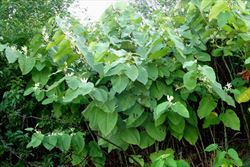
infestation (Photo: Jan Samanek, State Phytosanitary Administration, Bugwood.org)
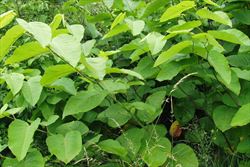
habit (Photo: Jan Samanek, State Phytosanitary Administration, Bugwood.org)

leaves (Photo: Sheldon Navie)

leaf (Photo: Sheldon Navie)
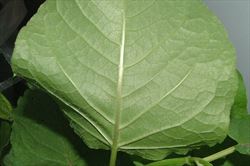
close-up of leaf underside showing hairs (Photo: Sheldon Navie)
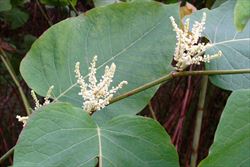
flower clusters (Photo: Jan Samanek, State Phytosanitary Administration, Bugwood.org)
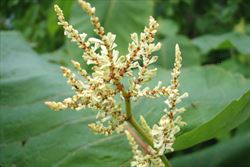
flowers and developing fruit (Photo: Jan Samanek, State Phytosanitary Administration, Bugwood.org)
Scientific Name
Fallopia sachalinensis (Schmidt) Ronse Decr.
Synonyms
Polygonum sachalinense SchmidtReynoutria sachalinensis (Schmidt) NakaiTiniaria sachalinensis (Schmidt) Janch.
Family
Polygonaceae
Common Names
elephant ear, giant knotweed, ostrich fern, sachaline, Sakhalin knotweed, spreading knotweed
Origin
This species originated in northern Japan (i.e. Hokkaido and Honshu) and north-eastern Russia (i.e. Sakhalin Island and the Kurile Islands).
Naturalised Distribution
Giant knotweed (Fallopia sachalinensis) is not widely naturalised in Australia, currently being limited to a few isolated infestations on the central tablelands of New South Wales and in southern Victoria.
However, it is widely naturalised in other parts of the world (e.g. in Europe and North America).
Notes
Giant knotweed (Fallopia sachalinensis) is regarded as a potentially serious environmental weed or "sleeper weed" in many parts of southern Australia. It has the ability to rapidly invade riverbanks, riparian areas and sites subject to disturbance, displacing all other vegetation by shading and root competition. Its long-lived underground stems (i.e. rhizomes) are able to penetrate to great depths and spread over large distances laterally, making established infestations very difficult to remove. This provides giant knotweed (Fallopia sachalinensis) with a competitive advantage over other less vigorous native plants. It also forms dense thickets of aboveground vegetation which shade out other species and prevent their regeneration, reducing the biodiversity of invaded areas and altering the habitat available to native animals.
Giant knotweed (Fallopia sachalinensis) is already a significant environmental weed in parts of Europe and North America.

